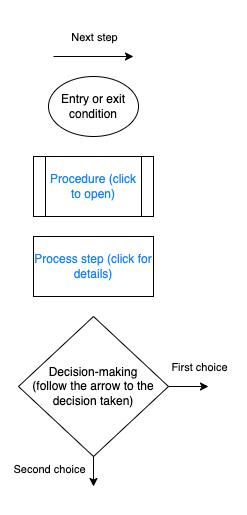The user interfaces of the N0C web hosting platform do not reproduce the sequence of initial product configuration steps, as these steps are punctual in time and specific to each new user. Moreover, the structure of the knowledge base is modelled on that of the user interfaces. As a consequence, new users who have to configure N0C often ask themselves the legitimate question: where do I start?
That is where this article comes in: you can save yourself a lot of unnecessary trial and error by taking the time to read the following lines, which will guide you through the entire initial N0C configuration process.
How to Use the Article
The many possible scenarios led us to use flow diagrams to clarify the text. As this approach is not suitable for all our readers, we have included a short video explaining the process : N0C Configuration.
Here are the conventions used in our flow diagrams:
Prerequisites
Before configuring N0C, the following steps are essential:
- register your domain name;
- register your hosting;
- connect to your main domain or sub-domain through https://mg.n0c.com/en/.
Procedure
The configuration of N0C for your domain or sub-domain must be undertaken in a structured and rigorous manner. By clicking on this link, you can access a diagram similar to the one below, which shows the steps for configuring your N0C:
Simply click on the boxes to open the sub-procedures or articles that will guide you through your tasks.
First Step — Activate Protections
Please make sur to activate the protections for:
- two-factor authentication (TFA) (see the article How to Set Up Your Account for Two-Factor Authentication);
- SSL/TLS management (see the article How to Manage SSL/TLS);
- DNSSEC keys management (see the article How to Manage Domains);
- Web App Firewall (WAF) configuration (see the article How to Configure the Web App Firewall (WAF) and View Firewall History).
Second Step — Messaging (E-Mails)
Configure messaging to manage domain-related e-mails (see the article How to Manage Emails Accounts).
Also, make sure to authenticate e-mail accounts (see the article How to Manage Emails Accounts):
- if the domain uses the DNS of the N0C platform, the configuration of the different authentications is done automatically, but it is possible to activate or deactivate DKIM, SPF and DMARC protections individually (see the paragraph Automatic Configuration);
- If the domain does not use the DNS of the N0C platform, you must add the entries manually on your DNS zone at the third party registrar (see the paragraph Manual Configuration).
Third Step — Websites, Blogs and Forums
Determine the file structure of your website using the Local and N0C Storage interfaces in the file manager (see the article How to Use the File Manager).
Then create your website, blog or forum using:
- the N0C WordPress application or a CMS such as Joomla, PrestaShop or Drupal (see CMS/Applications related articles); or
- the Site Builder software (see Site Builder related articles).
Langages
If required, configure the languages used for your applications, such as PHP, Ruby, etc. (see Languages related articles).
Fourth Step — Cron Tasks
If necessary, manage your Cron tasks (see the article How to Manage Cron Tasks and Associated Emails).
